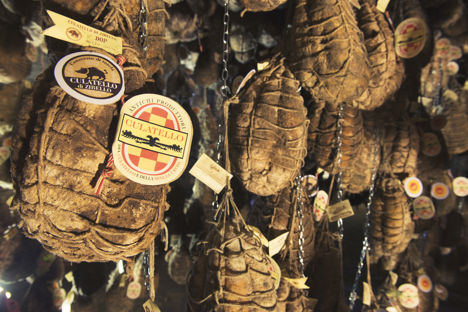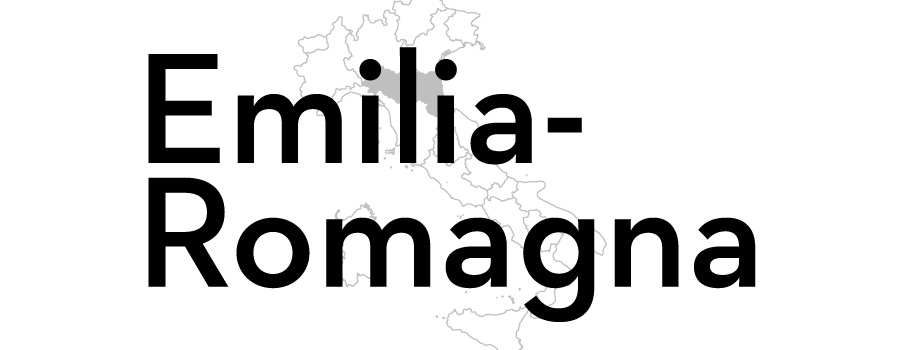
Culatello di Zibello: Emilia-Romagna's best-kept secret
Prosciutto di Parma isn’t the only delicious ham to come from Emilia-Romagna – the lesser-known culatello is one of Italy’s most valuable hams, prized for its delicate flavour and long, careful ageing process. Discover why it's held in such high regard.
Culatello di Zibello: Emilia-Romagna's best-kept secret
Prosciutto di Parma isn’t the only delicious ham to come from Emilia-Romagna – the lesser-known culatello is one of Italy’s most valuable hams, prized for its delicate flavour and long, careful ageing process. Discover why it's held in such high regard.
When you think salumi in Emilia-Romagna, you understandably think of Parma ham (or Prosciutto di Parma) – it’s the ubiquitous face of Italian cured meat across the world. Travel to Emilia-Romagna, though, and you’ll find the locals are obsessed with a totally different salumi, something altogether smaller, uglier, smellier, and far more valuable – Culatello di Zibello.
Don’t be surprised if you haven’t heard of it before – this ham rarely travels outside of the local area, and is only made in small quantities compared to its world-famous counterpart. Follow the Po River east from Piacenza, and it forms the border between Emilia-Romagna and Lombardy – the two food-obsessed regions share its fertile banks, prospering in different ways. Various communes sit along the southern bank of the river but only eight produce culatello. They only do so for six months every year, making this one of Italy’s most in-demand cured meats.
Whilst Parma ham production spans a huge swathe of Emilia-Romagna, a unique quirk of the Po Valley microclimate means that this is the only place in the world where true culatello can be produced. Prosciutto requires a steady dry breeze, but culatello gets its unique flavour and texture from the heavy fog that hangs in the valley during the winter – the cold, moist conditions that result from this mist encourage a completely different set of moulds to grow on the outside of the culatello, giving the salumi a sweeter, milder flavour. That fog has been rolling in for hundreds of years, and over the centuries farmers began using the phenomenon to their advantage.
Culatello di Zibello has been made using the same methods for hundreds of years, with processes handed down from generation to generation in many families. One such family is that of Massimo Spigaroli – head chef and owner of Antica Corte Pallavicina, an agriturismo and Michelin-starred restaurant in Polesine. Massimo’s culatello is famous across the country as some of the best there is – thousands flock to Polesine every year to have a taste, and chefs around the country buy his culatello to serve in their restaurants, including Massimo Bottura at Osteria Francescana in nearby Modena. He's also served his salumi to Prince Charles, who loved it so much he orders a whole one to be sent over to the UK regularly.
Culatello is a very exclusive product, not just because of the small geographical region it is made in, but also in terms of the process involved. Only pigs that have been raised and slaughtered in Emilia-Romagna and Lombardy can be turned into culatello, and even then only the large hind leg muscles are used (as opposed to prosciutto, which uses the whole haunch). The muscle is removed from the leg before being salted and wrapped in twine. It's then left to rest for a couple of days, at which point the salt is massaged further into the meat. One the meat has rested in a cold place (inhabitants of the Po Valley often use their basements) it is encased in a pig’s bladder, which is then tied up ready for the maturation process.
After a year of maturing, the culatello is nearly ready to eat, save for a couple of days of preparation. After being rinsed and brushed clean, the ham is soaked in Fontana del Taro – a sparkling white wine typical of Emilia-Romagna – then removed of all skin and fat before finally being sliced by hand and served. From start to finish, Culatello di Zibello is a labour of love, and that is reflected in the flavour – mild, sweet and delicate, with incredible creamy fat. Although culatello can be made with any breed of local pig, Massimo makes a special batch every year at Antica Corte Pallavicina that uses the native black pigs of Emilia-Romagna – the same breed that would have been used to make the hams hundreds of years ago. Black pigs are smaller and they don’t grow as quickly as regular pigs, but their flavour is extraordinary – much richer and fattier than the regular version. This is the culatello that makes its way to Osteria Francescana every year, after a whopping forty-two-month ageing process.
With something as special as culatello, there really is only one way to eat it – on it’s own! Combining it with anything else only distracts from the intensely complex flavour of the ham itself. Even in Italy – a nation that is blessed with hundreds of special food products – culatello stands out as something extremely special. If you’re planning a visit to Emilia-Romagna, this is a food experience not to be missed.

